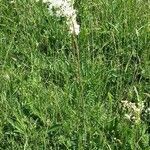Perennial herb, up to 80 cm tall at flowering, usually not branched except in infl.; stems glabrous, erect, arising from a woody, tuberous stock. Lvs pinnate, chiefly in basal rosette; petiole amplexicaul, up to 10-(18) mm long, pale, grooved, puberulent; blade narrowly oblong to oblanceolate, 100-150-(250) × 20-40 mm, divided into 8-18-(20) pairs of leaflets, interspersed with reniform, laciniate lobes; leaflets irregularly pinnatifid, to 20 mm long, glabrous on both surfaces or sparsely ciliolate, the lower surface slightly paler than upper; rachis glabrous except near base; stipules short, laciniate, adnate to petiole at base; cauline lvs smaller. Infl. terminal, up to 20 cm long and usually about the same width; primary branches ± erect, purplish, grooved, glabrate. Fls shortly pedicellate, usually 6-merous. Sepals fused at base; lobes c. 1.5 mm long, oblong, obtuse, rose-flushed, reflexed after flowering. Petals broadly obovate, c. 5 mm long, rounded, creamy white. Stamens numerous, c. = petals. Fr. of erect, inward curving, prominently hispid achenes, 3.5-5 mm long.
More
Sparsely hairy or glabrate, to 8 dm; lfls 10–25 pairs, 1–2 cm, ovate-oblong; pet usually 6, white, 5–9 mm; frs straight, pubescent; 2n=14, 16. Native of Eurasia, occasionally escaped from cult. in e. U.S. May–July. (F. hexapetala)
It grows 60-90 cm high. It spreads 45 cm wide. It forms clumps. It has tubers. The leaves are fine and feeathery or carrot like. The flowers are white and in crowded heads.












